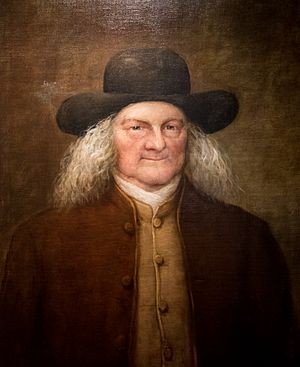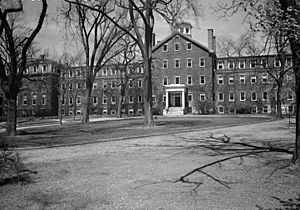Moses Brown facts for kids
Quick facts for kids
Moses Brown
|
|
|---|---|
 |
|
| Born | September 23, 1738 Providence, Rhode Island
|
| Died | September 6, 1836 (aged 97) Providence, Rhode island
|
| Spouse(s) | Anna Brown (m. 1764 – d. 1773) Mary Olney (m. 1779 – d. 1798) Phoebe Lockwood (m. 1799 – d. 1808) |
| Children | Sarah Brown Obadiah Brown |
| Relatives | Chad Brown, ancestor Nicholas Brown, brother John Brown, brother Joseph Brown, brother John Brown Francis, grandnephew |
| Signature | |
 |
|
Moses Brown (born September 23, 1738 – died September 6, 1836) was an important American figure. He was known for fighting against slavery and for helping to start the Industrial Revolution in America. He helped build some of the first factories that used machines to spin thread. One famous factory he supported was Slater Mill.
Contents
Early Life in Providence
Moses Brown was born in Providence, Rhode Island on September 23, 1738. His father, James Brown II, was a successful merchant. Moses's family was involved in many businesses, including making rum and iron. Sadly, his father died when Moses was very young, in 1739.
Moses was raised by his uncle, Obadiah Brown. The family business was large and included shipping. In 1764, a ship called the Sally, which was part of the slave trade, had a very difficult voyage.
Family Business and Education
After his uncle Obadiah died in 1762, Moses and his three brothers, Nicholas, Joseph, and John, took over the family business. They renamed it Nicholas Brown & Co.
The Brown brothers were also very involved in starting a college. This college was first called the College in the English Colony of Rhode Island and Providence Plantations. It was later renamed Brown University after Nicholas's son. The family was part of the Baptist church in Providence. Their ancestor, Chad Brown, helped found Providence with Roger Williams.
Moses Becomes a Quaker
Moses Brown married his cousin Anna Brown in 1764. They had two children who lived: Sarah and Obadiah. Moses also served in the Rhode Island General Assembly from 1764 to 1771. He helped oppose the Stamp Act in 1765. In 1769, he helped move the college to Providence. The Brown brothers gave family land for the new campus.
Moses's wife Anna died in 1773. After this, Moses slowly left the family business. He became more involved with the Quakers. In 1774, he formally joined the Society of Friends. Quakers are known for their peaceful beliefs and their opposition to slavery.
American Revolution
Moses Brown and his brother Joseph played a small role during the American Revolutionary War. Their brother John was arrested in connection with the Gaspee incident. This event was important in leading up to the war. Moses and Joseph tried to negotiate for John's release.
Later Life and Contributions
In 1779, Moses Brown married his second wife, Mary Olney, who was also a Quaker. They were married for 18 years.
Birth of the American Industrial Revolution
In 1788, Moses Brown briefly returned to business. He started a textile project with his cousin and future son-in-law. Moses became very interested in new ways to use water power for textile mills, like those in Britain. He hired Samuel Slater, an English immigrant, to help build a similar mill in Pawtucket, Rhode Island.
In 1790, this factory became the first water-powered spinning mill in America. This event is often seen as the start of the American Industrial Revolution. Moses's son Obadiah and Samuel Slater joined the partnership, forming the company Almy, Brown & Slater. Moses soon stepped back from daily work but remained a partner.
Community Involvement
After helping start the mill, Moses Brown focused on other activities. He helped Rhode Island approve the U.S. Constitution in 1790. He was also interested in farming and helped start the Rhode Island Agricultural Society in 1800. He supported public health, advocating for sanitation during a yellow fever outbreak in 1797. He also helped bring smallpox vaccination to Rhode Island.
Moses's second wife Mary died in 1798. He married his third wife, Phebe Lockwood, in 1799. She passed away in 1809, and Moses remained unmarried for the rest of his long life.
Peace and History
Moses Brown was a pacifist, meaning he believed in peace and opposed war. The War of 1812 inspired him to work for peace. He helped found the Rhode Island Peace Society in 1818. He also believed that Quakers should refuse to pay taxes that supported war.
He was also very interested in local history. He collected many old documents about colonial Rhode Island. He helped found the Rhode Island Historical Society and left most of his papers there after he died.
Moses Brown died from a stomach illness in Providence on September 6, 1836. He lived a very long life, outliving his wives and children.
Fighting Against Slavery
After seeing the terrible effects of the slave trade, Moses Brown decided to stop being involved. He broke away from his brothers' business in this area. After becoming a Quaker, he began a long fight against slavery. He became a leading voice against the slave trade in Rhode Island.
In 1773, he freed the last of his own enslaved people. After the American Revolutionary War, he worked even harder against the slave trade. He wrote articles and helped share anti-slavery pamphlets. He was very important in getting a law passed in 1787 that banned Rhode Islanders from participating in the slave trade.
In 1789, he helped create the Providence Society for Abolishing the Slave Trade. This group worked to make sure anti-slavery laws were followed. He also helped pass a law in the U.S. Congress to stop foreign slave ships from being prepared in American ports. Moses Brown was also known for helping enslaved and free Black people individually, offering money and legal help.
His brother John, however, was one of the state's main slave traders. John was even the first person charged under federal laws that banned importing enslaved people.
Moses Brown School
Moses Brown made a huge contribution to education. He played a key role in bringing back the New England Yearly Meeting School. This school for Quakers had existed on and off but had closed due to lack of interest.
In 1814, Moses Brown gave 43 acres of land in Providence to the Yearly Meeting. He worked hard to create a school on this land. He gave a lot of money and donated his impressive book collection to the school library. His son Obadiah also supported this effort until his death in 1822. Moses Brown served as the school's treasurer until shortly before his own death in 1836. The school was renamed the Moses Brown School in his honor in 1913. It is still a leading preparatory school today.
Images for kids



